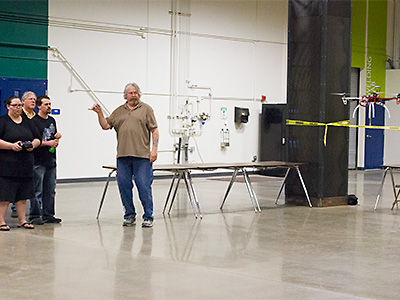
Students in the Unmanned Aerial Systems (UAS) Program at TMCC practice flying drones, develop competencies in UAS theory and build rotary-wing and fixed-wing systems.
A new set of regulations take effect in August that will encourage companies to launch more products based on Unmanned Aerial Systems (UAS) and create numerous jobs needed for this fast-growing industry.
The document is the Small Unmanned Aircraft Rule (Part 107), released on June 21 by the Department of Transportation, Federal Aviation Administration (FAA). It sets up the standard parameters to operate small, commercial Unmanned Aerial Vehicles (UAV), or drones.
“This will have a big impact on what businesses can do with drones,” said Mark Sharp, UAV Instructor at Truckee Meadows Community College. “There was a large participation from industry in setting up the regulations. It takes the mystery away for people starting businesses, and taking away uncertainty is better for companies.”
He said it’s also better for students who are exploring the many careers related to UAS.
“Before these newly established standards, you needed a Sport Pilot’s license to operate a drone for commercial purposes,” Sharp said. “Sport Pilot’s licenses could cost between $9,000 to $14,000. Now, after learning fundamentals and getting solid preparation, the license test will cost around $165.”
Joe Sanford, a classroom volunteer who is a retired electrical and systems engineer, agrees.
“Companies will know what costs to expect and will be able to create new products,” he said. “Employers are looking for people that are trained in UAS theory, have solid competencies and good judgment. They are looking to TMCC for well-trained employees with skills, common sense and maturity.”
TMCC offers an Unmanned Aerial Systems Technician Certificate of Achievement. Sharp and Sanford agree that the new set of standards helps companies price projects and labor more reliably.
“It’s an exciting opportunity for people of all ages to get involved in a rapidly growing industry,” Sanford said. “It’s the next big thing that will touch nearly every facet of our lives and make a wide array of tasks more efficient, cheap and safe to carry out.”
Opportunities in UAV Include Much More than Flying and Repairing Drones
Piloting drones will only be a small percentage of the careers available in UAS. A wide array of associated occupations will include:
- Systems upkeep and repair
- Product development
- Software development
- System development
- Mission and project planning
- Computer programming of autopilots and integration of systems
- Developing algorithms, mathematic calculations
- Data processing and compiling
“The number of data processing jobs will be large and it takes someone with a good attention to detail,” Sharp said. “Data picked up on sensors and cameras will be input to computer programs to create a multitude of products like topographic maps, making spectral diagrams, computing volume of reservoirs and estimating watershed.”
Drones can collect a vast amount of data very quickly and many new products will be built with that data. He added that employers have been looking for people skilled in UAS fundamentals and some computer science because staff will be operating expensive computer-directed technology.
“You need to know how the control station talks to the drone and what frequencies might conflict with each other,” he said. “Another part is safety. You need to know safe landing procedures, such as when the battery is low. We teach the fundamentals well here at TMCC.”
Operational Rules
The new FAA rule, Part 107, takes effect in late August for non-hobbyist drones weighing less than 55 pounds. The regulations apply to those flying UAV for hire, commercially, at 0 feet to 400 feet above the ground.
To fly commercially, one needs to be at least 16-years-old and pass a multi-part written test given at an Airman Knowledge Testing Center. When applying for the test, the Transportation Security Administration (TSA) does a background check on the applicant. Successful completion of the test earns a Remote Pilot Airman Certificate with a Small UAS Rating.
Types of Hiring Companies
Sharp and Sanford say that the new FAA rules will stimulate many startups. Existing employers also include:
- Aerial photography providers
- Civil engineering companies
- Farmers and ranchers
- Forestry and wildlife agencies and organizations
- Land survey providers
- Law enforcement
- Mining companies
- Transportation agencies
- Municipalities (for flood control)
- Real estate companies
- Utility companies
“Really, the list is almost endless,” Sharp said. “There is a need to look at land that is either remote, or hard to access or dangerous. Drones can help with search and rescue, with changing topography or with chemical spills. They can cover an enormous amount of territory.”
Sanford encourages both men and women to explore this growing field.
“Also, for the students who are interested in flying UAV, there is the growing sport of drone racing,” he said. “ESPN has signed on to cover it and there have been some large prize amounts, as well.”
Privacy
“Privacy is lesson one of my course, on day one,” Sharp said. “The FAA is primarily concerned with keeping a safe airspace for all. Nevada laws cover more about privacy and the expectation of privacy. When you fly a drone, you need to be aware of and respect people’s homes and other businesses’ buildings.”
The UAV technologies classrooms and lab is currently undergoing the second phase of renovations at the William N. Pennington Applied Technology Center. The lab space is being enlarged and there will be a dedicated area for work with drone-building composite materials.
For more information about studying UAV technology at TMCC, contact the Technical Sciences Division.






